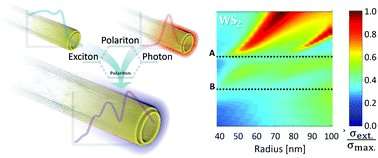Optical secrets of disulfide nanotubes are disclosed

An international collaborative of researchers has demonstrated a strong light-matter interaction in suspensions and self-assembled films of tungsten disulfide nanotubes (NT-WS2). The results of the research are published in Physical Chemistry Chemical Physics.
In this work, the optical properties of inorganic WS2 nanotubes are studied in detail. The main part of the research was carried out under the supervision of Prof. Reshef Tenne (Weizmann Institute of Science, Israel), who discovered tungsten disulfide nanotubes in 1992. Today, NT-WS2 are synthesized at semi-industrial scale and employed in numerous commercial lubricating mixtures, as well as laboratory-scale nanocomposites and nanoelectronic devices. However, for a long time, optical studies of such nanotubes remained controversial. For example, the features manifested in optical extinction spectra of WS2 nanotube suspensions were mistakenly interpreted as the set of excitonic absorption peaks. However, this approach hardly explained both the significant shift of the exciton energies with respect to the bulk WS2 values and the differences in optical extinction spectra of the NT-WS2 suspension and semi-oriented films.
Based on a complex study of NT-WS2 optical properties, the researchers from Weizmann Institute of Science and the Faculty of Materials Science, MSU, have demonstrated strong visible and near-infrared light scattering by disulfide nanotubes, leading to the masking of excitonic peaks. Importantly, the optical measurements employing an integrating sphere allowed registering "true" absorption signal, which showed that the nanotube excitonic peaks have almost the same energies as for bulk WS2.
More detailed study of the optical extinction and scattering spectra, fortified by finite-difference time-domain (FDTD) simulation and a phenomenological coupled oscillator (PCO) model, has shown that NT-WS2 exhibits strong light-matter interaction and forms exciton-polaritons. This part of the research was carried out by researchers from Weizmann Institute of Science and the Laboratory of Nanophotonics and Metamaterials, Faculty of Physics, Lomonosov MSU, headed by Prof. Andrey A. Fedyanin. It was demonstrated that WS2 nanotubes act as quasi 1-D polaritonic nano-systems and sustain both excitonic features and cavity modes in the visible-near infrared range.
"The findings of this thorough and truly international research allow consideration of tungsten disulfide nanotubes as a platform for developing new concepts in nanotube-based photonic devices. Moreover, the knowledge on such nontrivial optical features of these nanostructures sheds light on the possible light-harvesting properties of the nanocomposites based on disulfide nanotubes and plasmonic nanoparticles (gold or silver) which are extensively developed by young scientists from Faculty of Materials Science, MSU," said Alexander Polyakov, the co-author of the article.
More information: Lena Yadgarov et al. Strong light–matter interaction in tungsten disulfide nanotubes, Physical Chemistry Chemical Physics (2018). DOI: 10.1039/C8CP02245C
Journal information: Physical Chemistry Chemical Physics
Provided by Lomonosov Moscow State University



















